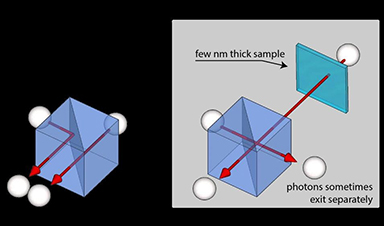The University of Warwick and QuantIC researchers at Heriot Watt University and the University of Glasgow performed a study in optical sensing, which could considerably enhance the precision of measuring nanoscopic structures.
QuantIC is part of the UK National Quantum Technologies Program and is the UK Quantum Technology Hub in Quantum Enhanced Imaging.
The researchers used pairs of photons, which are essential components of energy that make up light, to develop a method that determines the thickness of objects that are less than a 100,000th of the width of a human hair.
In the latest technique, two near-identical photons are fired onto a component called a beamsplitter and their subsequent behavior is monitored – with some 30,000 photons detected every second, and 500bn in use during an entire experiment.
Identical photons tend to ‘buddy up’ and continue to travel together – the outcome of a mild quantum interference effect. As a result of this, the team’s newly developed setup provides the same stability and precision as current one-photon methods that, owing to the equipment needed, are more expensive.
Providing a host of promising applications, such as research to better understand DNA, cell membranes, and even quality control for nanoscopic 2D materials of one atom’s thickness, for example, graphene, the latest study represents a major improvement on current two-photon techniques with up to 100 times better resolution.
Image Credit: University of Warwick
News This Week
Very low LDL-cholesterol correlates to fewer heart problems after stroke
Brigham and Women's Hospital's TIMI Study Group reports that in patients with prior ischemic stroke, very low achieved LDL-cholesterol correlated with fewer major adverse cardiovascular events and fewer recurrent strokes, without an apparent increase [...]
“Great Unified Microscope” Reveals Hidden Micro and Nano Worlds Inside Living Cells
University of Tokyo researchers have created a powerful new microscope that captures both forward- and back-scattered light at once, letting scientists see everything from large cell structures to tiny nanoscale particles in a single shot. Researchers [...]
Breakthrough Alzheimer’s Drug Has a Hidden Problem
Researchers in Japan found that although the Alzheimer’s drug lecanemab successfully removes amyloid plaques from the brain, it does not restore the brain’s waste-clearing system within the first few months of treatment. The study suggests that [...]
Concerning New Research Reveals Colon Cancer Is Skyrocketing in Adults Under 50
Colorectal cancer is striking younger adults at alarming rates, driven by lifestyle and genetic factors. Colorectal cancer (CRC) develops when abnormal cells grow uncontrollably in the colon or rectum, forming tumors that can eventually [...]
Scientists Discover a Natural, Non-Addictive Way To Block Pain That Could Replace Opioids
Scientists have discovered that the body can naturally dull pain through its own localized “benzodiazepine-like” peptides. A groundbreaking study led by a University of Leeds scientist has unveiled new insights into how the body manages pain, [...]
GLP-1 Drugs Like Ozempic Work, but New Research Reveals a Major Catch
Three new Cochrane reviews find evidence that GLP-1 drugs lead to clinically meaningful weight loss, though industry-funded studies raise concerns. Three new reviews from Cochrane have found that GLP-1 medications can lead to significant [...]
How a Palm-Sized Laser Could Change Medicine and Manufacturing
Researchers have developed an innovative and versatile system designed for a new generation of short-pulse lasers. Lasers that produce extremely short bursts of light are known for their remarkable precision, making them indispensable tools [...]
New nanoparticles stimulate the immune system to attack ovarian tumors
Cancer immunotherapy, which uses drugs that stimulate the body’s immune cells to attack tumors, is a promising approach to treating many types of cancer. However, it doesn’t work well for some tumors, including ovarian [...]














Leave A Comment